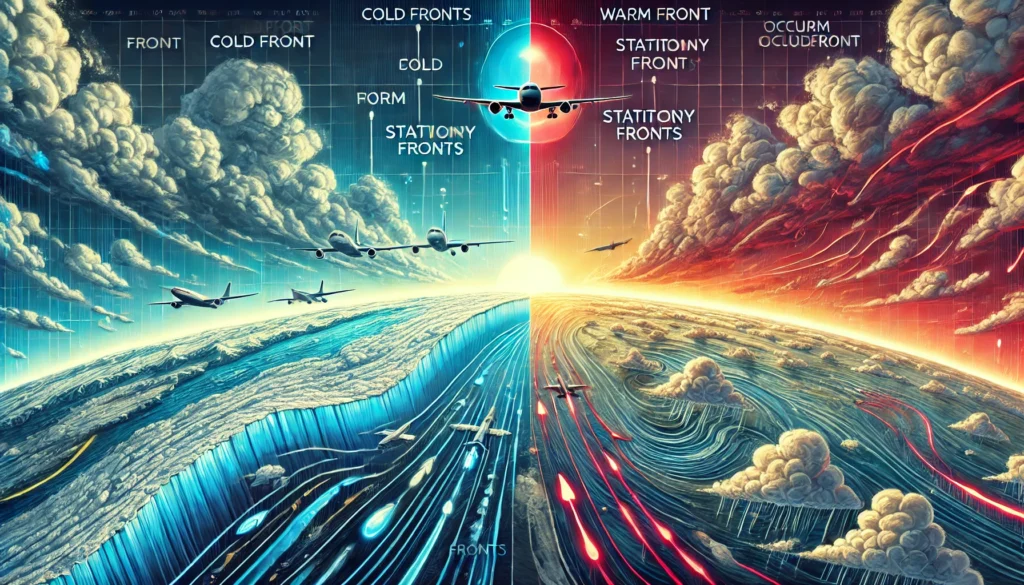The sky is equally as important to an aircraft as its engines, and both need to be mastered fully for smooth operations. Imagine cruising through the boundless blue when suddenly the nice seamless flow of air turns into winds that threaten your safety.
The reason why this happens is weather fronts, or the boundaries that separate two distinct air masses, because they have the power to enhance flights to challenges and back.
In our latest blog post titled From Cold to Warm, we look at how aviation weather fronts works. Cold air meeting warm air comes with its own set of problems, and so does turbulence.
As a seasoned pilot or an excited passenger, this title is sure to make you buckle your seat belt for the informative ride that lies ahead.
Introduction to weather fronts and their significance in aviation
Aviation and Meteorology are not casual words on the dictionary. Each poses not one, but two branches of study and when collided, their combination tackles the field of engineering.
Weather as a topic of discussion is quite personal to those in the metrology field because it directly impacts their lives. Weathering, for example, is a fundamental consideration when travelling. When it comes to weather, fronts have a vital importance as do power stations and solar systems have in aviation.
An airplane’s successful flight operations depend on the understanding of varying weather fronts. Each weather front has its own concerns and opportunities. These weather boundaries determine smooth flying experiences and turbulence.
This post will discuss the lever of aviation that weather fronts impact: cold, warm, occluded, and stationary borders. Unlike spacecraft, airplanes have a dynamic set of weather conditions to monitor throughout the entire journey. Not only do these fronts alter navigational demands, they require a comprehensive understanding of dynamic meteorological processes to avoid putting lives at risk.
Cold fronts occur when warm air gets placed underneath cold air. There tends to be a shift in weather condition accompanied by thunderstorms and heavy rainfall at the time of occurrence.
Warm fronts appear when there is an abundant amount of warm air sliding over a cold section. These fronts are often sole providers for prolonged precipitation while unleashing cloud cover over the area.
A dynamic with less complexity is an occluded boundary where cold fronts creep towards warm ones. The shifts often result in severe storms but give in to an untouched complex set of weather patterns which make for smooth sailing.
Like all other fronts, stationary fronts are unique too. They don’t move much and can linger for days. This weather pattern region could cause light rain or cloudy skies for extended periods because neither the warm nor the cold air mass takes control.
Stationary and cold fronts are equally important for all pilots. Each has different impacts on flying conditions, so failure to recognize either on time while airborne would be fatal for aviators.
Types of weather fronts: cold, warm, occluded, and stationary
A steeper than usual drop in temperature accompanied by downturn blizzards, static memories of the past with a classic playlist at the background, and the formation of cumulonimbus clouds said to be associated with heavy precipitation are some triggers of cold fronts formation. The entire event will take place once a new cold, denser mass of air takes the crown under a warmer mass.
Like the name, warm fronts develop stratus clouds that produce consistent drizzle or rain while gently lifting over a cold mass. Unlike it’s name, warm fronts are not all gentle. Visibility will often reduce before the front passes leading to the need for trainers with a fighter ready at any moment.
Cold fronts overlapped by warm fronts result in a chaotic wonderland where the weather becomes a jumble of nature’s paints. Static shock occluded fronts are these wonderlands filled with unpredictable weather, varied cloud types, and anything else wonderous you can dream of.
When air is not under the control of warm or cold dominators, stationary fronts will take the rule. They pose no luck to anyone wishing for nature’s magic with endlessly cloudy views and light drizzling rain for days. These concepts are of great significance in the flying world where predicting changing weather is crucial.
Characteristics of each type of weather front and how they form
Weather fronts are important in the configuration of flying conditions. Expect a cold front to bring in strong winds and rough turbulence. Such changes can catch even the most seasoned pilots off guard.
An approach of a warm front usually brings steady rainfall accompanied by low cloud cover. As visibility diminishes, the possibility of complicated landings or take offs rises. Pilots must stay alert during such shifts.
An occlusion front is a combination of warm and cold fronts which results in disorganized weather patterns. These boundaries are best crossed with ample stock of flight supplies due to unpredictable weather.
As any front approaches, rapid weather changes become imminent which makes safety measures a necessity. Conducting thorough briefings before flights is a fundamental way of ensuring up-to-date pilots are educated about existing weather conditions.
The use of radar technology to identify various types of fronts during the flight increases situational awareness, aiding smoother flying. With constant supervision throughout the flight, changes to the routes can be made accordingly.
The impact of weather fronts on flying conditions and safety measures for pilots
A couple of misconceptions made by many pilots and aviation enthusiasts associated with weather fronts are bound to lead to confusion. One of the predominant sayings is that all storms are preceded by cold fronts. Although storms accompany them often, that is not always the case.
Another misconception is that warm fronts move slowly and only produce light rain. In fact, they can yield short bursts of intense precipitation over small distances, which can catch unprepared pilots by surprise.
Some people also believe stationary fronts do not affect flying conditions at all. However, these aircraft-digesting barriers can linger for days, resulting in cloud cover and associated turbulent weather.
Lastly we have the assumption that the fronts systems make all weather shifts deterministic and predictable. The remains complex, with unanticipated changes still possible even with advanced forecasting technology. Knowing these is crucial for improving safety in aviation operations.
Case studies:
In January 2020, a significant winter storm surged through the Midwest. The combination of a strong cold front colliding with warm air masses advanced the region’s turbulence as well as low visibility which enhanced the need for pilots to reroute which resulted in numerous flights being delayed or canceled.
Another incident happened in July of 2019, where a stationary front stalled over the Southeast of the United States. The boundary produced clouds that thunder stormed violently, but shed numerous bolts of lightning and dislocated wind. Due to such drastic shifts in weather, a regional airline faced multiple flight cancellations.
On the other hand, an event in April 2021 demonstrated how warm fronts can improve flying conditions. Airlines noted that during the period of precipitation, takeoffs and landings became significantly easier once the rain started to let up.
Such cases demonstrate how different types of fronts affect the level of available aviation safety, operational decisions, and daily flight planning by airlines in real time throughout the day.
Tips for pilots:
Each pilot needs to know how to identify different kinds of fronts. Cold fronts give a clear sign of expected weather change with ever volatile shifts, like sudden temperature drops and increase in turbulence. Lowering altitude to a smoother air layer is recommended.
Expect gradual weather shifts at warm fronts as well. Make sure to look out ahead for cloud formations as they typically signal rain or promise for even lower visibility conditions. Slowing down and remaining alert to environment shifts is paramount.
For stationary fronts, be extra careful about still lingering distressing fog covering radar and storm obscuring weather. These systems tend to be very erratic so incorporating them into your radar watch is vital.
Occluded fronts bring their own set of complexities. They frequently bring weather of different complexities and intensity. Remain on guard for sudden changes in wind direction and speed—be careful!
Still report to ATC about the weather and other frontal phenomena. Plan alternate routes if required to guarantee safety from any kind of front.
Final Thoughts: weather fronts monitoring is vital for aviation operation.
For those engaging in the aviation industry, monitoring and analyzing weather fronts poses significant importance. Weather fronts impact the operations of flights and can compromise safety. Each front—cold, warm, or occluded or stationary—brings its unique set of complexities and requires a distinct approach for effective navigation.
Weather patterns change from time to time and with their evolution brings a new set of emerging socio-political challenges. It is crucial for pilots to track the ever-changing weather cycles and assess the work for changes to anticipate challenges that would surface along the course. For comfort and safety, it is ideal if pilots navigate through all types of fronts provided they possess the right tools to make navigational changes.
Knowledge is power; understanding the types of fronts and their accompanying challenges allows pilots to formulate appropriate strategies that can improve outcomes for everyone in the system. Rest assured that much evolution is anticipated in the aviation sector with close monitoring of the dynamism in the weather systems.

